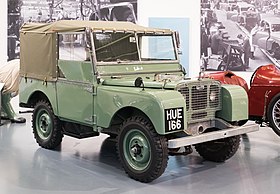
Back Land Rover Series Danish Land Rover Series German Land Rover series Basque Land Rover Series French Land Rover Series ID Land Rover Series Malay Land Rover Series NB Land Rover Series Polish Land Rover Series Russian Land Rover Series Swedish
This article needs additional citations for verification. (July 2007) |
| Land Rover series | |
|---|---|
 The first pre production Land Rover R01 | |
| Overview | |
| Manufacturer |
|
| Production | 1948–1985 |
| Assembly | Solihull, England Linares, Spain (Santana Motors) |
| Body and chassis | |
| Class | Off-road vehicle |
| Layout | FR layout / All-wheel drive |
| Chronology | |
| Successor | Land Rover Ninety & One Ten / Defender |
The Land Rover Series I, II, and III , or simply the Land-Rover (commonly referred to as Series Land Rovers, to distinguish them from later models) are compact British off-road vehicles, produced by the Rover Company since 1948, and later by British Leyland. Inspired by the World War II jeep, it was the first mass-produced civilian four-wheel drive car with doors, and an available hard roof. Contrary to conventional car and truck chassis, it used a sturdier fully box-welded frame. Furthermore, due to post-war steel shortage, and aluminium surplus, Land Rovers received non-rusting aluminium alloy bodies, favouring their longevity. In 1992, Land Rover claimed that 70% of all the vehicles they had built were still in use.
Most Series models feature leaf-spring suspension with selectable two or four-wheel drive (4WD), however Series I's produced between 1948 and mid-1951 had constant 4WD via a freewheel mechanism, and the Stage 1 V8 version of the Series III featured permanent 4WD. All three models could be started with a front hand crank and had the option of front & rear power takeoffs for accessories.
After adding a long wheelbase model in 1954, Land Rover also offered the world's first four / five door, 4WD off-road station wagon in 1956. Series Land Rovers and Defenders continually excelled in space utilization, offering (optional) three abreast seating in the seating rows with doors, and troop seating in the rear, resulting in up to seven seats in the SWB, and up to ten seats in the LWB models, exceeding the capacity of most minivans, when comparing vehicles of the same length.
© MMXXIII Rich X Search. We shall prevail. All rights reserved. Rich X Search